Nature Conservation 2025 — 31. 7. 2025 — Nature and Landscape Management — Print article in pdf
Czechoslovak Army Large-scale Mine/CSA Quarry: the Ever Biggest Ecological Restoration Project in th
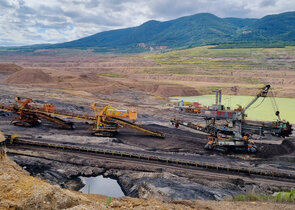
Brown coal or lignite surface/open-pit mining, together with subsequent infrastructure and industry, has damaged the landscape in the region below the Krušné hory/Ore Mountains (northwestern Bohemia) over an area of over than 300 km2, including structural changes in the human settlement pattern.
Today, as the brown coal energy industry is in decline and the end of mining is approaching ever more rapidly1, individual large-scale mines/quarries having been gradually closed in the Sokolov and Most basins. In 2024, several years ahead of the original estimate, the Czechoslovak Army Large-scale Mine/CSA Quarry will terminate mining. If we are talking about the largest mining operation in terms of area, which is associated with the devastation, degradation and destruction of nature, there is an opportunity to implement the largest Czech ecological restoration project after the mining operation is completed.
1 While, based on the recommendations of the so-called Coal Commission, the termination of active brown coal mining was estimated between 2036 and 2038, followed by a discussion of 2033, it is now clear that the economics may approach the termination horizon before 2030.
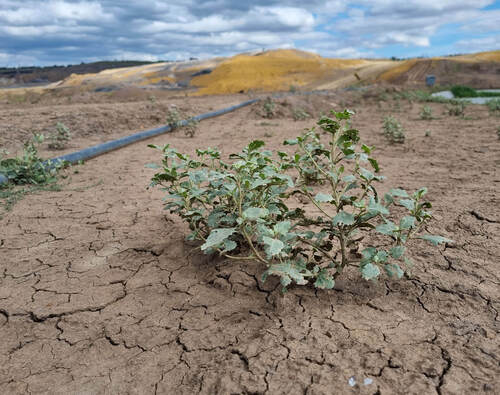
The archaeophyte tumbling saltbush (Atriplex rosea) forms rich growths in the Czechoslovak Army Large-scale Mine/CSA quarry. However, it has almost disappeared in the rest of the Czech Republic due to intensive changes in synanthropic habitats and is therefore classified as a critically endangered species. © Pavel Pešout
Remediation and technological reclamation plans have been prepared for all brown coal mines/quarries. The more progressive plans designate 10% of the area for ecological restoration, where the use of natural processes is envisaged. The Ležáky, Medard-Libík and Chabařovice large-scale mines/quarries have already been rehabilitated and reclaimed just in this way. In others (e.g. Vršany, CSA), significant areas of dumps have been technologically reclaimed2.
2 Non-productive habitats supporting the overall functioning of the landscape and favouring ecological functions (alleys of trees, hedgerows, balks, forest edges, spontaneously evolving patches, sandbanks, wetlands, etc.) make up less than 9% of the already reclaimed brown coal quarries/mines and dumps in the Most Basin (Hendrychová et al. 2020).
The financially demanding technological hydric, forestry and agricultural reclamations have opened the question of their economic efficiency. It is not only that their implementation is extremely costly (paid for by mining companies), but also their subsequent maintenance is quite expensive (paid for by the state), see for example Lake Most or Lake Milada (Pešout et al. 2021). The result of technologically reclaimed areas is an artificial landscape without habitat diversity with low resistance and resilience, and thus with questionable sustainability.
Long-term monitoring of the technical reclamation and reclamation effects using ecological restoration methods has repeatedly confirmed that ecological restoration at incomparably lower input and subsequent maintenance costs allows the development of valuable habitats colonized by endangered species (Bejček & Tyrner 1980, Hodačová & Prach 2003, Hendrychová 2008, Tropek & Řehounek 2011, Vojar et al. 2012, 2018, Jongepierová et al. 2018). The gradual colonization of the area after mining maintains a mosaic of various habitat patches and provides suitable living conditions for various guilds of species. As the temporal and areal onset of the various successional stages depends on local conditions (geological substrate, carrying capacity, slope, waterlogging, etc.), which are highly variable in the post-mining area, a diverse mosaic of vegetation is created there. It consists of sites without vegetation, sites partially overgrown with space gap herbaceous or shrub vegetation to areas continuously overgrown with already developed shrub layer and scattered trees. Self-established forest stands also often display higher biological activity in the soil, more efficient decomposition of dead organic matter, and produce more woody matter, usually already during around the 25th year of their development (Frouz et al. 2008, 2015).
The above knowledge logically generates the search for a more efficient, and more importantly, more sustainable solution for the remaining quarries/mines. Given the extraordinary size of brown coal quarries/mines, the issue has been addressed directly by the Government of the Czech Republic, systematically since 2017 (see box bellow).
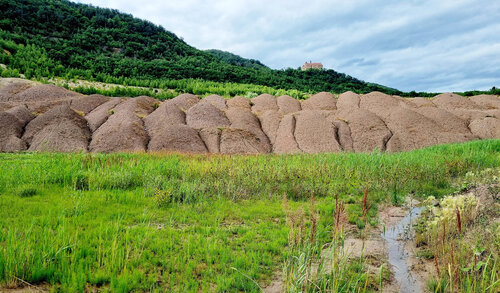
On the slopes of the pit there are numerous springs, particularly at the foot of the Krušné hory/Ore Mountains slopes. Around them, from a point of view of nature history valuable wetlands are formed. © Pavel Pešout
Pilot project in the Czechoslovak Army Large-scale Mine/CSA Quarry
The Nature Conservation Agency of the Czech Republic (NCA CR), scientific institutions and NGOs have long been striving for a wider use of ecological restoration in the reclamation of post-mining areas. These efforts began to be included into national and regional (= sub-national) strategic documents and policies a decade ago (Pešout et al. l.c.). In specific cases, ecological restoration has so far only been applied on a small scale (e.g. Jongepierová et al. 2018, Hendrychová et al. 2020). Therefore, in 2018, the NCA CR initiated negotiations with the Palivový kombinát/Fuel Combined Company Ústí nad Labem, state enterprise (now part of the DIAMO, state enterprise), and the energy group Sev.en Energy on the delineation of larger areas left to spontaneous development in the Czechoslovak Army Large-scale Mine/CSA Quarry and the Vršany Large-scale Mine/Quarry. After one year, a mutual co-operation agreement was concluded (Pešout et al. l.c.).
The agreement was successfully fulfilled and gradually a large continuous area was identified in the Czechoslovak Army Large-scale Mine/CSA Quarry, which has been spared technological reclamation so far, with exceptional biodiversity and the presence of endangered species, most of which is state property. The advantage of the selection is the low percentage of agricultural and forest land temporarily taken out from agricultural and forest management there, as most of the large-scale mine/quarry area had been covered by Komořany Lake, Dřínov Lake respectively. An important fact is, of course, the imminent termination of mining in the Czechoslovak Army Large-scale Mine/CSA quarry.
In 2020, the Ministry of the Environment of the Environment had the proposal of the NCA CR, supported by a feasibility study (Hendrychová et al. 2020) and discussed with partners in the area, taken into account in the document to be submitted to the meeting of the Government of the Czech Republic. Therefore, after decades of discussion, ecological restoration has become an equivalent option for the restoration and use of large parts of the post-mining landscape within the Ústí nad Labem Region. The NCA CR in cooperation with the DIAMO, state enterprise and representatives of the mining company (Sev.En) subsequently delineated the area more precisely. After several meetings of the inter-ministerial working group, in 2023 (see box on the next page) the Government instructed the Minister of the Environment to submit a proposal for a National Natural Monument (NMP) on most of the as yet technically unreclaimed areas within the internal spoil heap of the Czechoslovak Army Large-scale Mine/CSA Quarry, provided that several conditions were met (e.g. the Specially Protected Area must not complicate the possible output of electricity to be generated from renewable sources in the remaining part of the spoil heap in the dismantled large-scale mine/quarry).
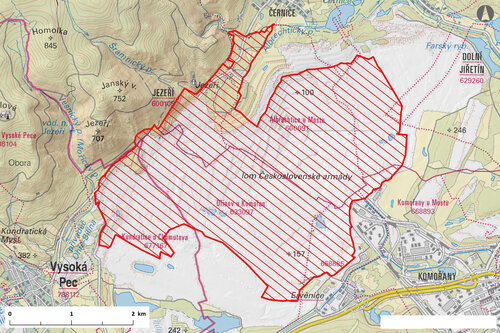
–– The proposed Czechoslovak Army Large-scale Open-pit Mine/CSA Quarry National Nature Monument.
The delineation of the Czechoslovak Army Large-scale Mine/CSA quarry National Natural Monument in the announced intention to be designated. Depending on the outcome of the objection hearing, there may still be slight changes. Source Nature Conservation Agency of the Czech Republic
Czechoslovak Army Large-scale Mine/CSA Quarry National Nature Monument
The proposal for the new Czechoslovak Army Large-scale Mine/CSA Quarry National Nature Monument (NNM) was announced by the Ministry of the Environment of the Czech Republic on April 29, 2024. The total area of the declared NNM is 1,230 hectares, making it one of the largest Specially Protected Areas in this category in the Czech Republic (map left on this page)).
The main reason for processing the project is to protect a unique complex of varied non-productive patches of lowland treeless habitat, valuable for specific biodiversity of great scientific importance, serving, inter alia, as a refugium for species of the cultural landscape. The environment is specific due to its physical and chemical features, geological and hydrogeological conditions, and the abundance of micro-habitats with rugged topography. The extent and development of the successional stages following surface/open-pit brown coal mining make it an area of supra-national importance.
Natural ecosystems linked to the post-mining area in all their developmental stages, active landslides at the foot of the Krušné hory/Ore Mountains and especially the populations of two flagship species - the Tawny pipit (Anthus campestris) and the Northern wheatear (Oenanthe oenathe), and particularly in view of the need for special management also the Jezeří Arboretum, are listed as the main objects of protection in the NPP proposed.
With regard to the objects of protection, more detailed protection conditions of the NNM are set. The area will be freely accessible to the public after the declaration. The use of boats, lighting fires, mass events with over 100 participants and the entry of motor vehicles (except for the Integrated Rescue System/Emergency Services and other authorised organisations) are subject to the prior approval by the State Nature Conservancy authority. It is not possible to place buildings and landfills in the area, change the water regime, use chemicals, change the land-use, etc. without permission.
The anticipated effective date of the Czechoslovak Army Large-scale Mine/CSA Quarry National Nature Monument’s declaration is July 1, 2025. The locally and materially competent nature protection authority will be the AOPK ČR, to which, according to the resolution of the Government of the Czech Republic, the state land in the NNM’s territory is to be transferred from the DIAMO, state enterprise.
Natural history significance of the NNM
The territory of the Czechoslovak Army Large-scale Mine/CSA Quarry National Nature Monument is a preserved refugium reminiscent of the extensively used agricultural and cultural landscape (fallow fields, balks, abandoned areas, rubble site/waste grounds, barren areas), which has almost disappeared from the Czech Republic due to chemicalization and intensification of agricultural production. The successional stages of dry and sunny barren habitats created by mining activities are supplemented by periodic and permanent water areas with variously formed littorals, which sometimes turn into wetlands on variously vertically modelled areas created during the establishment of the spoil heaps. Due to its size and diversity of micro-habitats, the unreclaimed Czechoslovak Army Large-scale Mine/CSA Quarry’s territory hosts a number of wild animal endangered species, particularly birds, amphibians, beetles, hymenopterans and butterflies.
To date, 227 specially protected or red-listed species have been documented in the proposed area (birds: 83, amphibians: 12, mammals: 14, invertebrates: 94, plants: 24; AOPK ČR, CZU 2022). Some species do not occur elsewhere in the Czech Republic (with the exception of the remaining brown coal/lignite open-pit mines/quarries in the Ústí nad Labem Region) or have over 90% of their national population there. These are mainly the objects of protection of the Tawny pipit (estimated population in the Czech Republic 120-150 pairs, of which in the Czechoslovak Army Large-scale Mine/CSA Quarry approx. of one third the population) and the Northern wheatear (estimated population in the Czech Republic 200-250 pairs, of which in the Czechoslovak Army Large-scale Mine/CSA Quarry approx. one third of the population). Both species with their habitat requirements are umbrella species covering habitat conditions for most of the other endangered species among amphibians and reptiles, hymenopterans, dragonflies, butterflies or beetles. The remnant of the original arboretum at the Jezeří Castle with a valuable entomofauna of saproxylic beetle species is also very specific.
|
The main steps leading to the decision to declare a National Nature Monument at the brown coal/lignite Czechoslovak Army Large-scale Mine/CSA quarry: |
|
2017 – Resolution of the Government of the Czech Republic No. 441 of June 14, 2017 ‘State Raw Materials Policy of the Czech Republic in the Field of Mineral Raw Materials and Their Resources’ mandates to propose legislative measures that will enable nature-based reclamation/restoration to be used on a larger scale. 2018 – the Nature Conservation Agency of the Czech Republic (NCA CR) initiated negotiations with the Fuel Combined Company Ústí nad Labem, state enterprise. and the energy group Sev.en Energy on the delineation of larger areas left to natural spontaneous development in the Czechoslovak Army Large-scale Mine/CSA Quarry and the Vršany Large-scale Mine/Quarry. 2019 – Signing a memorandum of cooperation between the NCA CR, the Fuel Combined Company Ústí nad Labem, state enterprise., and the Czech University of Life Sciences Prague on the identification of suitable areas for ecological restoration (AOPK CR 2019). 2020 – Based on the Resolution of the Government of the Czech Republic No. 421 of June 17, 2019, an inter-ministerial working group (Ministry of Industry and Trade, Ministry of the Environment, Ministry of Agriculture, ministerial organisations and representatives of mining companies) is established with the aim of proposing the most effective way of using the structurally affected area of the Ústí nad Labem Region affected by brown coal/lignite mining. 2021 – The Government of the Czech Republic, by its Resolution No. 344 of April 6, 2021 took note of the results of the analyses and sets down the further procedure for the optimal use of the residual surface brown coal/lignite pits in the Ústí nad Labem Region, including increased use of ecological restoration. 2021 – Richard Brabec, Minister of the Environment of the Czech Republic, suspends technological reclamation at the Czechoslovak Army Large-scale Mine/CSA Quarry. 2022 – Anna Hubáčková, Minister of the Environment of the Czech Republic, extends the suspension of technlogical reclamation at the Czechoslovak Army Large-scale Mine/CSA Quarry. 2023 – Resolution No. 479 of June 28, 2023 of the Government of the Czech Republic instructs the Minister of the Environment, through the NCA CR, to prepare a proposal for the designation of a Specially Protected Area national category in the Czechoslovak Army Large-scale Mine/CSA Quarry. 2024 – Petr Hladík, Minister of the Environment of the Czech Republic, submitted a proposal for the Czechoslovak Army Large-scale Mine/CSA Quarry National Nature Monument to the Government of the Czech Republic, which took note of it without comments. 2024 – The Ministry of the Environment of the Czech Republic started the process of declaring the Czechoslovak Army Large-scale Mine/CSA Quarry National Nature Monument with the assumption that the declaration will take effect on July 1, 2025. |
National Nature Monument Management Plan
In 2023, a management plan was developed for the future Czechoslovak Army Large-scale Mine/CSA Quarry NNM, which (due to the exceptional nature of the area) was discussed in an inter-ministerial working group and subsequently submitted for information to the Government of the Czech Republic. Its main objective is to ensure protection, conservation and management for the valuable communities in the former mining areas and to maintain the favourable state of the communities in various stages of succession. It is primarily concerned with maintaining the successional mosaic of habitat patches so that they form the most diverse coherent environment of treeless forests with a specific concentration of biodiversity. The primary objective is to maintain the character of this forest-free area, i.e. areas with different vegetation cover without invasive alien plant species across the majority of the area and thus to maintain suitable conditions for species of early successional stages, particularly the objects of protection of the NPP - the Tawny pipit and the Northern wheatear.
In most of the area, the management plan deals with spontaneous processes and the elimination of non-native plant species. In selected parts of the NNM, vegetation cover will be removed by heavy machinery in combination with diversified grazing and cutting of unsuitable woody plants/trees. The specific environment also requires specific interventions, and therefore controlled disturbance management will be possible in the area, which may be inappropriate in other environments (military exercises, off-road vehicles including motorcycles, etc.).
From the point of view of nature conservation in the Czech Republic, there is one more exceptional moment associated with the Czechoslovak Army Large-scale Mine/CSA Quarry. Following the government’s decision to establish a Specially Protected Area there, the update of the rehabilitation and reclamation plan has led to increased involvement in ecological restoration. The Remediation and Reclamation Plan is a binding document that determines the procedure and levelling outthe mining area. It is drafted solely from a mining perspective and in accordance with the Mining Act. In the updated Czechoslovak Army Large-scale Mine/CSA Quarry plan, thanks to the cooperation between the mining company and the NCA CR, reclamation is planned for the 12.3 km2 area of the NPP exclusively using ecological restoration methods there. Natural succession will be used in the area, suitable coal seam outcrops will be preserved, variously sized pools, water areas with shallow littoral, “field” wetlands will be created and previously unsuitably levelled parts of the terrain will be landscaped.
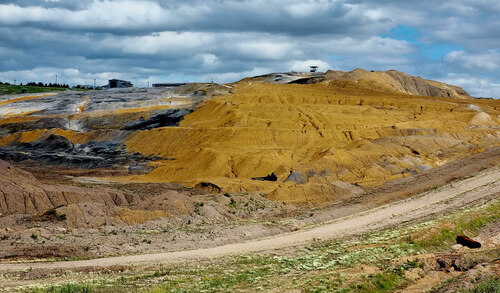
The varied geological bedrock/subsoil and composition of the dumps are one of the drivers fundamentally affecting the natural succession and biodiversity within the area. © Pavel Pešout
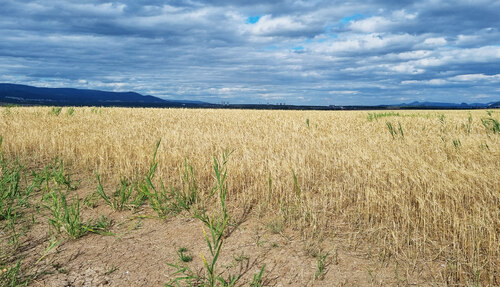
Agricultural biotechnical reclamation, i.e. levelling out and humusing of the areas, has already been carried out on part of the Czechoslovak Army Large-scale Mine/CSA Quarry spoil heaps. The result is not very fertile soils with biodiversity at the level of a normal agricultural landscape. The areas are not part of the declared National Nature Monument. © Pavel Pešout
Czechoslovak Army Large-scale Mine/CSA Quarry as a model for other quarries
The solution for the Czechoslovak Army Large-scale Mine/CSA Quarry was sought in advance compared to other brown coal/lignite large-scale mines/quarries in the Most Basin. This was mainly due to the early date of the planned end of mining. Therefore, from the beginning, the approach for the Czechoslovak Army Large-scale Mine/CSA Quarry was prepared and discussed as a pilot for other post-mining areas. Another brown coal/lignite large-scale mine/quarry where the tried and tested solution has already been applied is the Vršany Large-scale Mine/Quarry. There, too, the NCA CR in cooperation with the Czech University of Life Sciences Prague has elaborated the necessary analyses. On the basis of them and the energy potential assessment (location of the solar power stations), the inter-ministerial working group agreed on a solution that delineates an area of 4.8 km2 for ecological restoration. The Government, by its Resolution No. 298/2024, approved the proposed solution for the comprehensive and efficient use of the area of the Vršany Large-scale Mine/Quarry residual pit and ordered the NCA CR to prepare the designation of the National Nature Monument in the proposed scope also in this quarry.
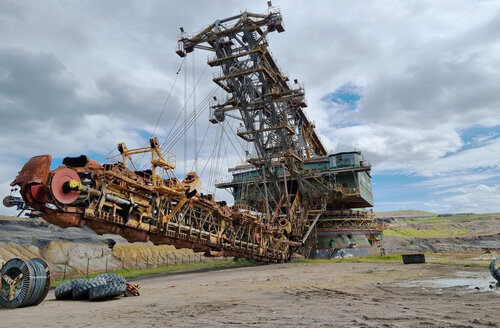
Thanks to the initiative of the Ústí nad Labem Region and the helpfulness of Severní Energetická (energy group Sev.En Energy), it seems that the largest machine in the country - the RK5000 excavator - will be preserved. The Nature Conservation Agency of the Czech Republic is counting on the possibility of keeping it in a suitable area within the National Nature Monument if the Ústí nad Labem Region decides to save the large machine and make it available to the public. © Pavel Pešout
The exact delimitation of the area is currently being discussed, which must respond to the definitive estimate of the termination of mining, which is permitted in the Vršany Large-scale Mine/Quarry until 2052, but for economic reasons may be terminated before 2030.
Other large-scale mines/quarries for which a higher involvement of ecological restoration is being discussed are the Bílina and Nástup Tušimice ones (Lake Libouš). However, suitable large areas, similar to the Czechoslovak Army Large-scale Mine/CSA Quarry and Vršany Large-scale Mine/Quarry are not available there, and so far, an area of hundreds of hectares has been identified for ecological restoration there. Large-scale ecological restoration projects, including the protection of the most important areas through National Nature Monuments in the Ústí nad Labem Region, are a major contribution to the Czech Republic’s commitments under the EU Biodiversity Strategy 2030 (Pešout 2020). A similar approach should also be applied in the Sokolov Basin, especially in the Družba-Jiří Large-scale Mine/Quarry, and ecological restoration methods should also be more used in other post-mining areas - quarries, sand and gravel pits. ■
- - - -
Cover photo: Brown coal/lignite mining at the Czechoslovak Army Large-scale Mine/CSA Quarry will be completed in 2024. Currently, reserves are being replenished at two locations. © Pavel Pešout
- - - -
The list of references is attached to the online version of the article at www.casopis.ochranaprirody.cz

